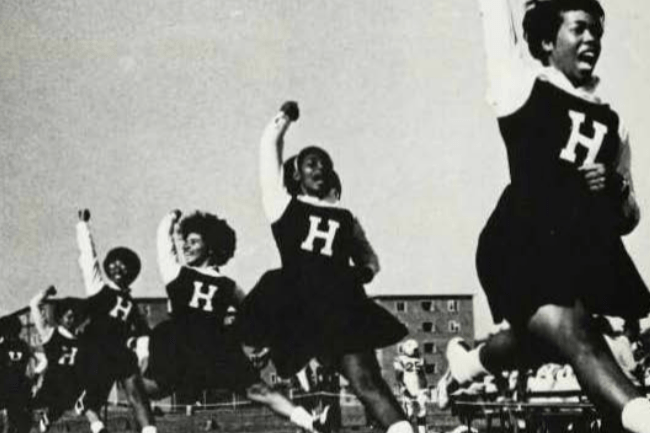HBCU homecomings are nothing new now, but they were novel in 1924.
Drawing on examples from Ivy League colleges, Howard University alumni took the Homecoming concept, added flavor, and created something entirely unique. It was one of the very first HBCU Homecomings and set the standard for an event that proliferated across HBCU campuses across the country and across the decades, touching millions of lives and making countless invaluable memories.
It has been called a “vibe,” a “rite of passage,” and an “epic piece of HBCU identity.” Howard’s Homecoming has been featured everywhere from the Washington Post to Vibe Magazine, but the New York Times may have described it most succinctly when they simple called it “a pilgrimage” in a 2019 article. Beyonce paid tribute to HBCU homecomings in her titular Grammy Award-winning Netflix documentary that year, which was watched by more than a million viewers on its first day, and the Smithsonian’s National Museum of African American History and Culture launched a digital experience in 2022 to chronicle the HBCU Homecoming phenomenon, prominently featuring the Howard event.
HBCU homecomings have a permanent place in American culture for their wonder, majesty, and mystery, but you must attend one to experience and understand them.
The Start of Something Big
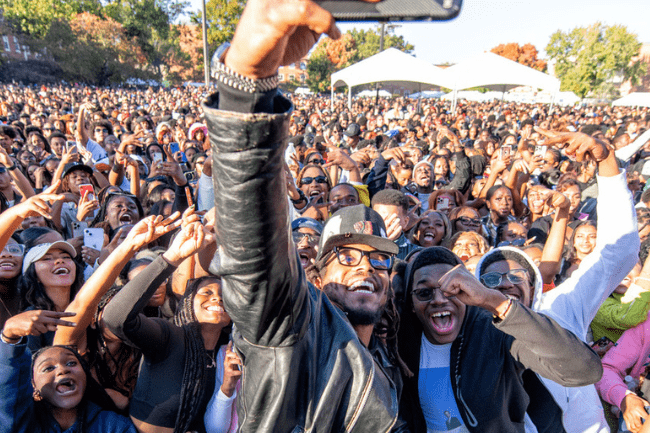
Howard Homecoming Yardfest, 2022
Lincoln University’s Lions and Howard University’s “Bulldogs,” as the team was known then, began their historic football rivalry as a Thanksgiving Day competition in 1893. (That year, Grover Cleveland was sworn in as president and Hattie McDaniel was born, who would go on to be the first Black person to win an Oscar, which she bequeathed to Howard.) The first game was organized by the students themselves, and 2,000 spectators stood around a field sans stadium.
In the early 1900s, schools like Yale and Harvard realized that football games against rivals generated more alumni interest than other university activities and began to produce “Homecoming” events to provide a venue to cultivate relationships with alumni. The annual event also triggered alumni financial support.
By 1924, the Howard-Lincoln game had been transformed into one of the first HBCU classics. It was, as an article in The Hilltop, argued, “the athletic and social event for Negroes in America,” which could only be likened to the Army-Navy game. Each year, thousands attended the classic between the Lions and the “Bison” as Howard’s team had now come to be known, but the bulk of revenue went to commercial entities which were not associated with either university. Both schools lost money in the endeavor.
...destined to become one of the greatest events of the school year.
To capitalize on the classic’s popularity and to grow alumni support, Howard’s alumni organized the first Howard Homecoming that year. The game was accented by Howard University General Alumni Association sessions and receptions on the day before and day of the game. A bonfire lit the sky. It may have been a relatively modest start, considering the legendary status it has obtained since, but it was an effort Emory B. Smith (’14, ‘19L), Howard’s Alumni and Field Secretary, predicted would be the start of something big. Those who attended, Smith argued in The Hilltop, would “inaugurate a Howard Homecoming that is destined eventually to become one of the greatest events of the school year.”
An Undaunted Team and Fans
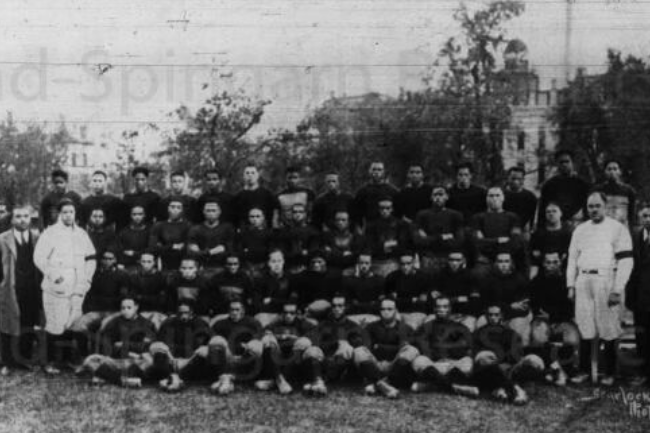
Howard Bison Football Team, 1924
The first Howard Homecoming game took place in Griffith Stadium, the stadium that was home to the Washington Senators and was located on the lot where Howard University Hospital now stands. It was cold and drab, according to The Bison yearbook, but fans were undaunted. An estimated 30,000 spectators packed the stands.
The “Bison,” as the Howard team was now known, had been beset by injuries all year. One player, Haywood “Speed Johnson,” had lost his life during the first game, against North Carolina A&T College. Another player had suffered a facial fracture during the season.
Nevertheless, Howard had not lost a game as they approached the contest with Lincoln. The squad of 40 players hailed from all over the country. In addition to Washington, DC, players were from Arkansas, Connecticut, Indiana, Iowa, Florida, Kansas, Louisianna, Massachusetts, New Jersey, North Carolina, Oklahoma, Pennsylvania, West Virginia, and Wisconsin. Guard P.L. Bacchus, who was from British Guiana, added an international element. To prepare, the team spent five days at a “secret camp,” where they worked on new plays.
Lincoln was having an incredible season, led by two-time All-American Frank “Jazz” Byrd,” whose athletic prowess had given opponents fits for years. Byrd played both halfback and quarterback for the Lions, in addition to running track and playing basketball.
The Lions roared to a decisive victory over Howard, with a score of 31-0. Later that year, Lincoln would win the CIAA football championship after posting an 8-0-1 record and outscoring opponents 306-3.
Despite the score, the Howard faithful stayed in the stadium long after the game, chanting and singing. They followed the band out of the stadium, belting out “Old Howard” to show their continued love for their Alma Mater.
All Traditions Have a Beginning
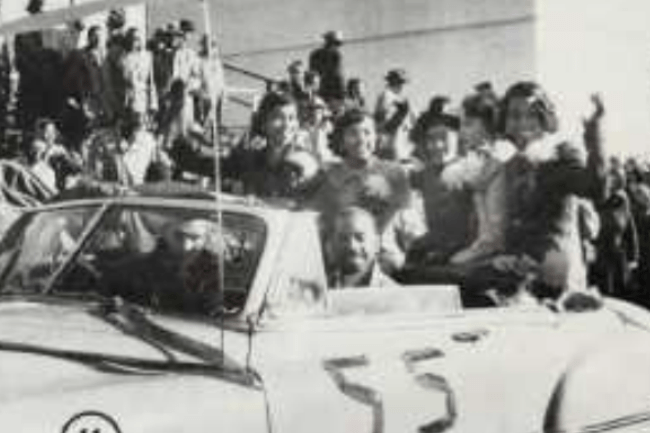
Howard Homecoming Parade circa 1955
Besides football, 1924 marked the start of other Homecoming traditions. Fashion was a focus, with attendees demonstrating “all the grace and splendor of the gilded aristocracy,” according to the Hilltop. Fraternities used the Friday after the game as a day to provide entertainment, a prelude to the Friday evening step shows showcased in recent years. The brothers of Kappa Alpha Psi, for example, hosted an inter-fraternity dance at Washington’s Dunbar High School. Then, as today, the Homecoming festivities attracted a “Who’s Who” of both Howard alumni and unaffiliated fans from across the country.
Fast forward to 2024, and nearly all HBCUs make Homecoming a centerpiece of their annual calendars. It is a manifestation of HBCU love— an affection extends well beyond alumni to families, friends, and total strangers who share in an annual fellowship. Indeed, some of the most loyal Homecoming attendees may not have set one foot inside a classroom, but they are nevertheless infatuated by the camaraderie, pride, and pageantry. Countless young people make their decision to attend college during an HBCU homecoming.
Like the Bison of old, today’s Howard fans remain undaunted. North Carolina A&T University may ostensibly claim to have the “Greatest Homecoming on Earth” (affectionately known as GHOE), Florida A&M University may have a grand annual “FAMUly” reunion, and Morehouse and Spelman’s “SpelHouse” may get its rightful share of attention. But there can be no doubt that Howard’s Homecoming is the only one that captivates the city that many believe to be the center of the Free World. Alumni buy out hotels, independently promoted events all over the city expand the experience beyond campus, the annual parade and vendors consume Georgia Avenue, and the official events on campus can only be described as legendary. If you live or work in the nation’s capital, you simply cannot help but to be a part of it.
You are making traditions that will live as long as Howard lives.
Back in 1924, a Hilltop writer waxed poetically about the unfolding beauty of the new occasion in an editorial entitled “Welcome Home Old Grads.”
“No romance is more enchanting than the return of children to the family fireside, where old acquaintances are renewed and memories of bygone days are refreshed amid familiar environments,” the editorial reads. “Forgotten friendships are awakened and stirred with a new intensity; the students of the present in noisy acclaim to Alma Mater, catch the echo of the shouts that have gone before. Graduates and students merge into one. The former lend a touch of sobriety and dignity to the reunion while the latter exhilarated the enthusiasm and pep which becomes contagious in the pep fest.”
“Welcome Home Old Grads,” it continues. “In laying aside important duties to be present on this auspicious occasion, you are making traditions that will live as long as Howard lives.
Keep Reading
-
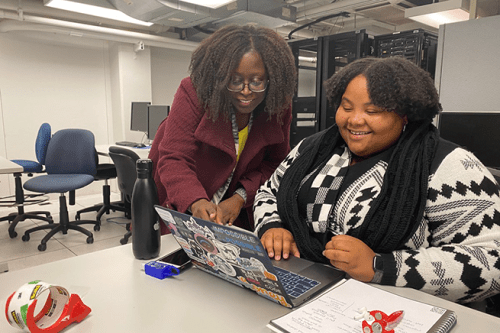 News
NewsHoward’s Human-Centered AI Institute Bridges Disciplines to Make AI Work for Humans
Dec 16, 2025 7 minutes -
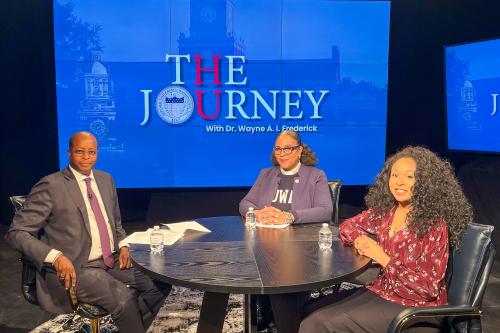 Epiphany
Epiphany‘The Journey’ Returns: Howard University Relaunches President’s Signature Conversation Series
Dec 15, 2025 3 minutes -
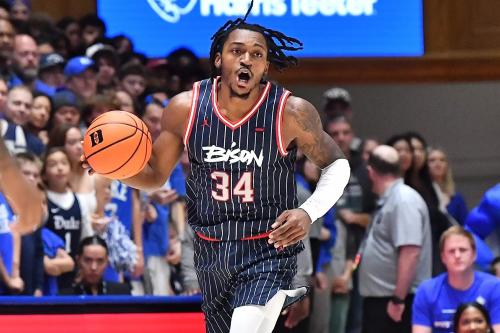 Student Athletes
Student AthletesHoward University to Face North Carolina A&T at Duke’s Cameron Indoor Stadium, Returning to the Site of MEAC History
Dec 3, 2025 4 minutes
Find More Stories Like This
Are You a Member of the Media?
Our public relations team can connect you with faculty experts and answer questions about Howard University news and events.
Submit a Media Inquiry

